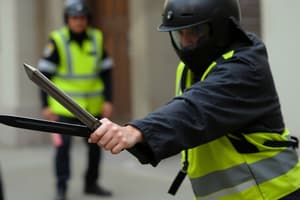Podcast
Questions and Answers
What is required for members to use techniques or defensive weapons to apply force?
What is required for members to use techniques or defensive weapons to apply force?
- Requisite training and departmental approval (correct)
- The member's prior experience in similar scenarios
- Approval by a senior officer only
- The member's intuition about the situation
Under what circumstances may members respond with deadly force?
Under what circumstances may members respond with deadly force?
- When the subject is verbally aggressive
- When the member believes it is necessary to protect themselves or others from imminent serious harm (correct)
- If a superior officer instructs them to do so
- Whenever they feel threatened, regardless of the situation
What should members do as the resistance offered by a subject decreases?
What should members do as the resistance offered by a subject decreases?
- Request assistance from backup officers
- Increase the level of force used to maintain control
- Lower the amount or type of force used (correct)
- Continue using the same level of force regardless of resistance
What must be true for the use of force to be considered objectively reasonable?
What must be true for the use of force to be considered objectively reasonable?
When should members avoid using defensive weapons or techniques?
When should members avoid using defensive weapons or techniques?
What behavior distinguishes an active resister from a mere non-cooperative subject?
What behavior distinguishes an active resister from a mere non-cooperative subject?
Which of the following is considered a defensive tactic?
Which of the following is considered a defensive tactic?
What is the primary purpose of employing defensive tactics?
What is the primary purpose of employing defensive tactics?
What is true about the potential for injury when using defensive tactics appropriately?
What is true about the potential for injury when using defensive tactics appropriately?
What kind of subject behavior leads to the classification of a threatening assailant?
What kind of subject behavior leads to the classification of a threatening assailant?
How should members respond to a subject exhibiting mechanical defiance?
How should members respond to a subject exhibiting mechanical defiance?
What distinguishes defensive tactics from the use of deadly force?
What distinguishes defensive tactics from the use of deadly force?
Which of the following is NOT considered a defensive tactic?
Which of the following is NOT considered a defensive tactic?
Under what circumstances may members choose to not handcuff subjects?
Under what circumstances may members choose to not handcuff subjects?
What should members do if a subject complains of pain associated with handcuffs?
What should members do if a subject complains of pain associated with handcuffs?
Which groups of individuals should be monitored for signs requiring medical assistance?
Which groups of individuals should be monitored for signs requiring medical assistance?
What is considered the proper use of handcuffs?
What is considered the proper use of handcuffs?
When may members need to use hand controls with a subject?
When may members need to use hand controls with a subject?
What must members do if they observe inappropriate use of force by another member?
What must members do if they observe inappropriate use of force by another member?
What happens if an investigation determines pain from handcuffs is not solely from their application?
What happens if an investigation determines pain from handcuffs is not solely from their application?
What is the protocol for monitoring subjects against whom force was used?
What is the protocol for monitoring subjects against whom force was used?
Who has the authority to change the duty status of a member involved in a serious use of force incident?
Who has the authority to change the duty status of a member involved in a serious use of force incident?
What actions can the Medical Services Division take in relation to a member involved in a serious use of force incident?
What actions can the Medical Services Division take in relation to a member involved in a serious use of force incident?
What is the composition of the Use of Force Review Board (UFRB) in terms of voting members?
What is the composition of the Use of Force Review Board (UFRB) in terms of voting members?
Which civilian member is NOT a voting member of the UFRB?
Which civilian member is NOT a voting member of the UFRB?
What role does the chairperson of the UFRB have regarding the rotation schedule?
What role does the chairperson of the UFRB have regarding the rotation schedule?
Which type of incidents is the UFRB responsible for reviewing?
Which type of incidents is the UFRB responsible for reviewing?
What is a requirement for civilian members appointed by the mayor to the UFRB?
What is a requirement for civilian members appointed by the mayor to the UFRB?
How long must the Patrol Services representative serve on the UFRB according to the rules?
How long must the Patrol Services representative serve on the UFRB according to the rules?
What should be done if a witness refuses to have their statement recorded?
What should be done if a witness refuses to have their statement recorded?
How soon must the USAO be notified about serious use of force incidents?
How soon must the USAO be notified about serious use of force incidents?
What should be included in the investigative file for serious uses of force?
What should be included in the investigative file for serious uses of force?
Which personnel should be involved during a tactical review for high-risk entry incidents?
Which personnel should be involved during a tactical review for high-risk entry incidents?
What is a critical aspect to document during every interview of members engaged in a serious use of force?
What is a critical aspect to document during every interview of members engaged in a serious use of force?
Why is it important to conduct documented analyses of the events surrounding an incident?
Why is it important to conduct documented analyses of the events surrounding an incident?
What type of incidents require prompt involvement of the IAD commanding official?
What type of incidents require prompt involvement of the IAD commanding official?
What actions should be taken immediately after an incident involving the use of force?
What actions should be taken immediately after an incident involving the use of force?
Flashcards are hidden until you start studying
Study Notes
Active Resister
- The subject actively resists the member's attempt to control them.
- The subject may be armed with a weapon and use evasive movements to avoid control.
- The subject will use physical actions like bracing, tensing, pushing, or verbal signals to convey their intent not to be held.
- The intent to resist must be clearly demonstrated.
- This level is beyond simple non-cooperativeness and indicates active aggression.
Threatening Assailant
- The subject goes beyond simple resistance and actively assaults the member, themselves, or others.
- The threat of an aggressive assault is imminent.
- The subject demonstrates a lack of concern for the member's safety.
- The subject does not pose an imminent threat of death or serious bodily injury to the member or others.
Defensive Tactics
- All force options besides deadly force are considered defensive tactics.
- The use of defensive tactics is aimed at forcibly subduing the subject.
- Defensive tactics are not intended to cause death or serious bodily injury.
- Members must adhere to policies regarding the use of specific force options and less lethal weapons.
Use of Force Requirements
- Members should use proportionate and objectively reasonable force to overcome resistance.
- The level of force should be adjusted based on the subject's resistance.
- If resistance decreases, the member should lower the force used.
- If resistance escalates, members are authorized to respond reasonably.
Handcuffing
- Proper application of handcuffs may result in complaints of minor pain or injury, but this isn't, in itself, a use of force.
- When a subject complains of pain related to handcuffs, an official should investigate.
- An investigation is initiated if the investigation official determines the injury or complaint is not solely due to the application of handcuffs or if force was used to apply them.
- If subjects resist handcuffing, members may need to use hand controls to move the subject's wrists, arms, or body for handcuff application.
Use of Force Investigations
- All members involved in the use of force, including those involved in events leading up to it, should be interviewed.
- Interviews should occur immediately after the incident and again after evidence collection.
- Interviews with subjects, members, and material witnesses should be audio or video recorded, if possible.
- Written narratives and signed statements are required if subjects or non-members refuse recording.
- All recorded statements should be transcribed and included in investigations.
- Investigations should document the possibility of de-escalation and whether there were any reasonable de-escalation opportunities.
- A documented analysis of the events leading up to and following the incident should be conducted.
- Defensive tactics instructors should conduct a tactical review of the member's actions.
- Emergency Response Team officials should be involved in the tactical review of high-risk entry incidents.
- The United States Attorney's Office should be notified within 24 hours or the next business day of serious use of force, deadly force, potential criminal conduct, vehicle pursuits involving a fatality, and in-custody deaths.
Use of Force Review Board
- The Use of Force Review Board (UFRB) reviews all IAD use of force investigations of MPD members.
- The UFRB also reviews investigations forwarded by the IAB assistant chief and vehicle pursuits resulting in fatalities.
- The UFRB consists of 13 voting members, including MPD members, civilians, and representatives from various organizations.
- The UFRB may also include non-voting members.
Studying That Suits You
Use AI to generate personalized quizzes and flashcards to suit your learning preferences.


